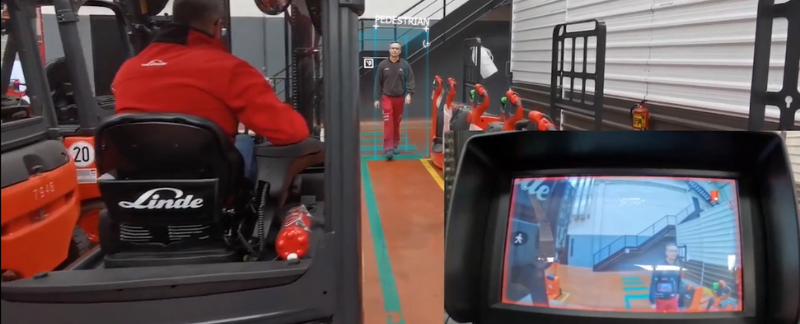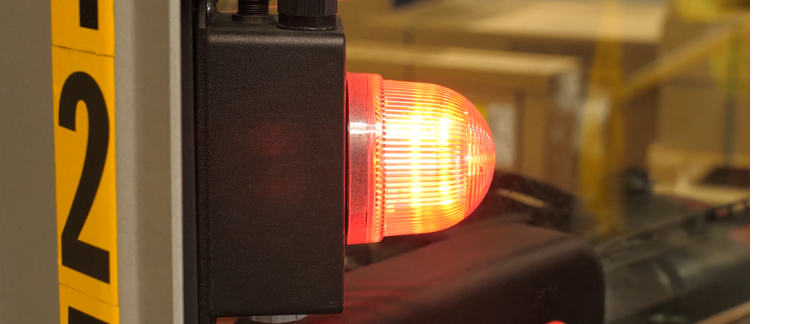Forklift Proximity Alarms for Workplace Safety
Forklift proximity alarms are transforming workplace safety by helping prevent collisions between machines and pedestrians. In busy industrial environments, these smart detection systems provide real-time alerts to reduce blind spot accidents and enhance operator awareness. With advanced solutions like Blaxtair’s AI-powered technology, companies can significantly lower risks and protect their workforce more effectively from potential hazards.
The Growing Need for Forklift Safety Solutions
Forklifts play a vital role in modern industrial operations, enabling fast and efficient movement of goods in warehouses, construction sites, logistics hubs, and manufacturing plants. However, their presence also introduces a substantial risk to workplace safety, especially for pedestrians operating in the same environment. According to the Occupational Safety and Health Administration (OSHA), nearly 70% of forklift-related accidents are preventable with the right combination of training and safety technology.
Each year, thousands of workers are injured or killed in incidents involving forklifts. Many of these accidents result from a combination of operator error, blind spots, limited visibility, and a general lack of awareness about the environment and its surrounding hazards. Despite the use of mirrors, horns, and warning signs which are useful, these traditional safety tools often fail to provide real-time information needed to prevent collisions.
This growing concern has sparked increased interest in innovative workplace safety solutions. One of the most effective solution is the forklift proximity alarm—a technology designed to detect hazards before they cause harm and alert forklift drivers to act in time. It provides real-time alerts to help mitigate risks.
How Forklift Proximity Alarms Work
Forklift proximity alarms use advanced detection technology to warn operators when they are too close to a pedestrian or obstacle. These alarms can be based on different technologies, including ultrasonic sensors, RFID tags, and AI-powered cameras. AI-based detection systems, go a step further by distinguishing between people and obstacles in real time, reducing false alarms and ensuring accurate alerts.
Traditional alarm systems rely on passive and basic proximity sensors that may not differentiate between a person and a static object, leading to unnecessary alerts or missed warnings. AI-powered systems, however, continuously analyze the environment and alert operators only when a genuine risk is detected. This significantly improves efficiency and reduces operator fatigue caused by frequent false alarms.
AI-based detection technologies adapt to the environment and maintain consistent performance, regardless of lighting, movement patterns, or warehouse configuration. This makes them highly effective in complex and fast-paced industrial settings.

Benefits of AI-Driven Proximity Alarms
Enhanced Pedestrian Detection
The primary advantage of AI-driven forklift proximity alarms lies in their superior ability to detect pedestrians accurately. By combining high-resolution cameras with real-time image processing, systems like Blaxtair, can recognize the shape and movement patterns of a human being and distinguish them from static objects, machinery, or debris.
This level of intelligence significantly reduces false alarms, preventing operators from becoming desensitized to warnings. When alerts are timely, accurate, and relevant, drivers are more likely to react appropriately, resulting in fewer near-misses and reduced risk of serious injury.
In environments where pedestrians and forklifts operate in close proximity, such as mixed-use zones in warehouses, this capability is critical. Early detection and precise alerts help operators slow down, stop, or maneuver safely, preventing accidents before they occur.
Compliance with Safety Regulations
Employers are legally responsible for providing a safe work environment, and regulatory bodies like OSHA require businesses to implement effective safety measures to minimize workplace hazards. Forklift proximity alarms help organizations meet these compliance standards by providing an additional layer of safety.
AI-powered systems not only meet compliance requirements, but also demonstrate a proactive safety culture. They enhance risk management strategies by ensuring that operators are always aware of their surroundings. Companies that invest in cutting-edge detection technology are better positioned to pass audits, avoid fines, and reduce their liability in the event of an incident.
Moreover, these systems can generate safety data and reports, helping safety managers analyze patterns, identify risk areas, and improve site-specific safety protocols.
Reduced Downtime and Costs
Accidents involving forklifts can have significant financial consequences, from equipment damage and medical expenses to operational delays and legal claims. By preventing collisions, businesses can reduce downtime, lower maintenance costs, and improve overall efficiency.
Proactive safety measures help create a safer and more productive work environment. AI-powered pedestrian detection systems are a cost-effective investment when you consider the long-term savings they offer. By preventing accidents, businesses can maintain smoother workflows, protect their assets, and avoid the high costs associated with injuries and insurance premiums.
Additionally, reducing workplace accidents boosts employee morale, lowers absenteeism, and contributes to a more productive and engaged workforce.
Implementing Proximity Detection in Industrial Environments
Integrating forklift proximity alarms requires careful planning to ensure maximum effectiveness. Each industrial site has unique characteristics that affect how and where detection technologies should be deployed. Factors such as warehouse layout, pedestrian traffic patterns, and operator training should be considered when selecting the right system.
An initial site assessment helps determine high-risk zones and optimal camera or sensor placements. For example, areas near loading docks, intersections, or high-storage racking are particularly vulnerable to blind spots and pedestrian interaction.
One of the key advantages of AI-based solutions like Blaxtair is their adaptability. They can be customized to fit different industrial settings, from busy distribution centers to outdoor construction zone, offering flexibility and enhanced protection. They are also compatible with any type of forklift and heavy machinery.
Training is another critical component. Operators need to understand how the proximity alarm works, what types of alerts to expect, and how to respond to them appropriately. Companies that pair smart technology with comprehensive safety training see the best results.
Real-World Applications
Real-world case studies demonstrate the effectiveness of proximity alarms in reducing accidents. For instance, companies in the automotive, retail, and logistics sectors that have implemented AI-powered detection systems report a significant decrease in collision risks and improved overall workplace safety. By leveraging advanced technology, businesses can proactively mitigate hazards and protect their workforce.
These real-world applications serve as proof that technology-driven solutions are not just theoretical: they’re practical, scalable, and highly effective at protecting human life.
The Future of Forklift Safety with AI
The future of workplace safety is increasingly reliant on AI and data-driven solutions. Next-generation forklift safety systems will increasingly integrate AI, machine learning, and real-time connectivity to provide even more accurate and efficient hazard detection. As industries continue to prioritize worker safety, AI-powered proximity alarms will play a crucial role in preventing accidents and ensuring compliance with evolving safety regulations. These enhancements will further enable predictive maintenance, heatmapping of high-risk areas, real-time fleet tracking and fleet management.
Connectivity will also enable centralized safety management. Safety officers will be able to monitor multiple forklifts in different locations through dashboards, gaining insights into operator behavior, alarm frequency, and pedestrian flow.
Autonomous forklift operation is another emerging trend. While full autonomy is still in development, AI-based proximity alarms lay the foundation by building trust in machine-powered decision-making and increasing operator confidence.
In short, AI is not just improving forklift safety, it’s transforming it.

Conclusions
Forklift proximity alarms are no longer optional. They are an essential tool for enhancing workplace safety and preventing accidents. With forklift-related incidents continuing to pose a serious risk, businesses must adopt smarter, more effective ways to protect their workers and operations.
AI-based systems, like those developed by Blaxtair, provide a reliable solution by accurately detecting pedestrians and reducing collision risks. As safety regulations become more stringent, investing in advanced detection technology is a proactive step toward creating a safer work environment. These solutions provide not just alerts, but peace of mind, helping reduce accidents, stay compliant with regulations, and foster a culture of safety.
For businesses looking to improve their forklift safety measures, AI-powered solutions offer the best combination of efficiency, compliance, and cost savings. Explore Blaxtair’s innovative pedestrian detection systems and take a step toward a safer, smarter workplace today.
